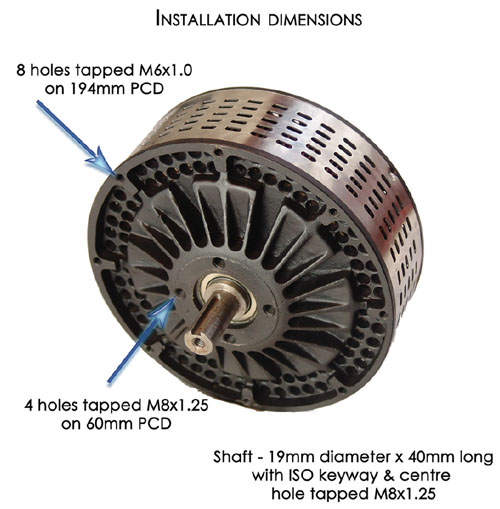Les moteurs Agni Motors sont développés par Cédric LYNCH et spécialement conçu pour les hautes performances.
Pour en savoir plus : wwwsaiettagroup.com (anciennement www.agnimotors.com)
| Doc PDF | rpm/V | V nom | Vmax | I cont@48V | Imax | Vitesse | Pmax | Pnom@48V |
| AGNI 95 | 71 rpm/V | 56 V | 60 V | 250 A | 400 A | 3400 tr/min@48V | 14 kW | 12 kW |
| AGNI 95 RI | 71 rpm/V | 56 V | 72 V | 250 A | 400 A | 5000 tr/min@72V | 26 kW | |
| AGNI 119 | 58 rpm/V | 68 V | 200 A | 300 A | 2780 tr/min@48V | 13,6 kW | 8,5 kW | |
| AGNI 135 | 50 rpm/V | 80 V | 170 A | 200 A | 2400 tr/min@48V | 13,6 kW | 7,6 kW | |
| AGNI 143 | 47 rpm/V | 86 V | 150 A | 300 A | 2256tr/min@48V | 12,9 kW | 6,5 kW |

Concernant le capteur de température du porte balai :
The two small wires coming from the brush holder are connected to a 33k negative-temperature-coefficient thermistor that has a resistance of 15 to 35 Kohms at ambient temperature and about 2 Kohms at the maximum acceptable temperature of the brush holder. In an application where there could be a risk of overloading or overheating, these wires should be connected to the controller circuit in such a way that the maximum current will start to be cut back when the thermistor's resistance falls below 4 to 5 Kohms and will be low enough to prevent further temperature rise when the resistance has fallen to 2 Kohms. The wires can simply be connected in parallel with the throttle potentiometer if it has a two wire connection, and 0 ohms = stop and 5 Kohms = full throttle.
La notice d'entretien du moteur AGNI
Elle est disponible ici sur le site de la société AGNI et également en copie locale (depuis octobre 2011).
Voir aussi : Jozztek 01 - How to recondition an Agni Motor - 95R Armature Removal.
Les dimensions du moteur AGNI
Lien : Fichier PDF, format A3, 421 Ko
